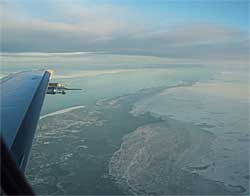Intensive Arctic Field Campaign Concludes
Published: 31 October 2004

The Mixed-Phase Arctic Cloud Experiment (M-PACE), the largest and most ambitious field campaign conducted thus far at the ARM Climate Research Facility North Slope of Alaska locale, concluded on October 23, after almost a month of concentrated measurement activity. The experiment involved four weeks of intensive ground, remote sensing, aircraft and radiosonde measurement activities focused on obtaining microphysical data on clouds consisting of both water droplets and ice crystals (i.e., mixed phase). Throughout much of the study period, radiosonde data was acquired at six-hour intervals from Barrow, Atqasuk, Oliktok Point and Toolik Lake. These four locations delimited the roughly rectangular study area.
To obtain in situ measurements, the University of North Dakota Citation aircraft probed low-level clouds (between 1,500 and 3,000 ft.) over the entire study area, but particularly over Barrow (ARM Climate Research Facility’s primary measurement site at NSA) and Oliktok. The Citation was based at Deadhorse/Prudhoe Bay, where experimental headquarters was also located. Another aircraft, the Proteus high altitude remote sensing aircraft, probed clouds in the area from about 25,000 to 43,000 ft. Proteus flights originated from Fairbanks, and most were timed to coincide with satellite overpasses. Pacific Northwest National Laboratory’s Atmospheric Remote Sensing Laboratory—a mobile measurement facility with many of the same instrument capabilities as the ARM Climate Research Facility fixed sites—was located at Oliktok Point, near the United States Air Force Long Range Radar Station. A tethered balloon measurement system was also deployed from this location. The Department of Energy’s Multispectral Thermal Imager satellite system surveyed Barrow and Oliktok at high resolution in 15 spectral bands as often as possible throughout the experiment.
Many months will be spent analyzing the data. However, early results show that observed low ice nucleation particle counts can, in part, explain the prevalence of super-cooled liquid clouds in the Arctic, even to temperatures as low as -25 °C. The microphysical characteristics of these mixed-phase clouds, where thoroughly documented under a variety of environmental conditions, provide the measurements needed to study the basic physics of these hitherto poorly understood clouds.
The ARM Climate Research Facility is a DOE Office of Science user facility. The ARM Facility is operated by nine DOE national laboratories, including .
Keep up with the Atmospheric Observer
Updates on ARM news, events, and opportunities delivered to your inbox
ARM User Profile
ARM welcomes users from all institutions and nations. A free ARM user account is needed to access ARM data.


















